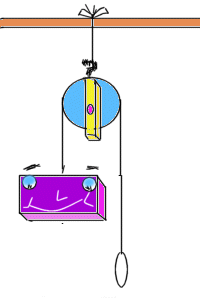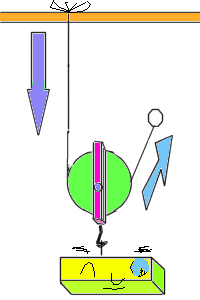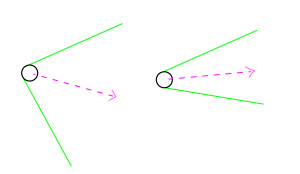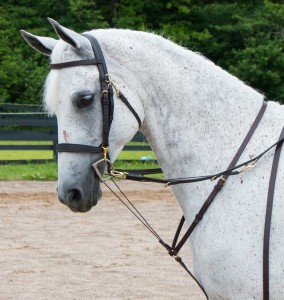These types of devices are quite commonly used throughout many disciplines, and I believe it’s very important to understand how they work and why you would want to choose one over the other (or maybe none at all).
Running Martingales
A running martingale is very popular as a training tool and can be used with a variety of bits. In general, a running martingale changes the direction of the pull on the reins without affecting the amount of force used. I’ve heard people say that a running martingale gives the rider “leverage,” meaning it increases their strength without them actually having to pull harder, but that in fact is incorrect.
 In physics terms, a running martingale is considered a fixed pulley. Fixed pulleys have no mechanical advantage – the amount of force you apply is the same amount of force the horse will feel on its mouth, just like as if you had a straight rein. (Well, if we want to get technical, a fixed pulley actually has a mechanical DISadvantage, in that you actually have to apply MORE force to get the same result.)
In physics terms, a running martingale is considered a fixed pulley. Fixed pulleys have no mechanical advantage – the amount of force you apply is the same amount of force the horse will feel on its mouth, just like as if you had a straight rein. (Well, if we want to get technical, a fixed pulley actually has a mechanical DISadvantage, in that you actually have to apply MORE force to get the same result.)
In the animation to the right, the weight represents the bit in the horse’s mouth, the pulley represents the martingale ring, and the rope is the rein.
Fixed pulleys (i.e. running martingales) serve one purpose – to change the direction of force. In the animation, the rope is being pulled down, yet the box moves up. The same thing happens when we ride. Our hands act in an upward direction against the martingale ring, but the horse feels a pull in a downward direction.
So when might you want to use a running martingale?
When the horse needs the bit direction to be lower than the rider’s hands. I think about where the reins are placed when we drive or long line – very low compared to when we ride. They are sometimes even lower when we use side reins – maybe as low as the rider’s knee. But when we ride, the reins are much higher. So using a running martingale can replicate that feeling of a lower rein for the horse. A lower rein tends to encourage a horse to lower their head and/or tuck their nose, which is why we often use a running martingale in combination with a straight rein.
A running martingale can also, in some cases, serve to buffer the transmission of signals from the rider to the horse and vice versa – so if you have a rider with poor hands, or a horse that is very sensitive to bit movement, a running martingale might be a good option to keep things a bit muffled. A recent study found that a running martingale can “help prevent inconsistent rein aids from novice riders being transmitted to the horse’s mouth” and in fact “reduces the tension applied on the horse’s mouth.”
Draw Reins
 Unlike the fixed pulley action of a running martingale, draw reins mimic a movable pulley, which has a force multiplier of two. This means that whatever amount of force the rider applies to the reins, the horse feels double. Of course, there is some friction involved, so it’s not exactly 2X the force, but it’s close. If your draw reins use a pulley, the multiplier is closer to two. If your reins pass through the bit ring, the friction will be higher and the force multiplier will be less than double – but still significantly multiplied.
Unlike the fixed pulley action of a running martingale, draw reins mimic a movable pulley, which has a force multiplier of two. This means that whatever amount of force the rider applies to the reins, the horse feels double. Of course, there is some friction involved, so it’s not exactly 2X the force, but it’s close. If your draw reins use a pulley, the multiplier is closer to two. If your reins pass through the bit ring, the friction will be higher and the force multiplier will be less than double – but still significantly multiplied.
In the animation, the rope is attached to a fixed object like the girth. The box and pulley represent the horse’s head and the bit, which move in response to the pull on the rein.
In addition to doubling the rider’s force, a draw rein will also change the direction of pull. Since the pulley is in the center, it will move towards the midway point between the attachment point and the rider’s hand. Essentially this means that the lower the rein is attached, the lower it will pull the head. The higher it’s attached, the higher it will pull the head. So attaching your draw reins to the girth between the horse’s legs will result in a much lower pull on the horse’s mouth than if you attach the reins at the stirrup bar. Also, the height of the rider’s hand will influence the direction of pull. The higher the hand, the higher the pull will feel to the horse – but the pull will never be directly to the hand. Instead, it will be to the midway point between the attachment and the hand.
In the drawing below, the black circle is the bit, the green line is the draw rein, and the pink line shows the direction of the force. Both setups have the exact same height of the rider’s hand, but a different attachment point. You can see how the direction of the pull is changed based on where the rein attaches. So if you want your horse to lower his head, attach the rein lower. If you want his head higher, attach it higher.
So when might you want to use a draw rein?
 Because a draw rein essentially doubles a rider’s strength, some people tend to use them on horses with tough mouths or a horse that might get out of control on occasion. My personal preference is not to use a draw rein for riding. I don’t like covering up the problem and making myself feel good, when underneath there are significant issues that need to be addressed. I’ll work on improving the horse’s mouth or responsiveness instead, and I prefer to use a running or German martingale for those tasks. However, I do like to use a draw rein for long lining and driving. The very long lines that are used for those activities represent a decrease in pulling power (the longer the lines are, the harder you have to pull to get the same amount of force on the bit), so using a draw rein can make up for that reduction in strength.
Because a draw rein essentially doubles a rider’s strength, some people tend to use them on horses with tough mouths or a horse that might get out of control on occasion. My personal preference is not to use a draw rein for riding. I don’t like covering up the problem and making myself feel good, when underneath there are significant issues that need to be addressed. I’ll work on improving the horse’s mouth or responsiveness instead, and I prefer to use a running or German martingale for those tasks. However, I do like to use a draw rein for long lining and driving. The very long lines that are used for those activities represent a decrease in pulling power (the longer the lines are, the harder you have to pull to get the same amount of force on the bit), so using a draw rein can make up for that reduction in strength.
I also like to use a draw rein to teach a horse “how” to respond to a cue (for example, if I want the horse to soften when I gently pull one rein). If the horse’s initial reaction is to brace against me and stiffen their neck, and I instead want him to soften and flex, I’ll employ draw reins to teach the horse how to respond. Once it becomes ingrained that a gentle pull means relax, then I’ll stop using the draw reins.
German Martingale
 A German martingale is essentially a combination of a draw rein, attached at the girth between the horse’s legs, and a straight rein. The setup acts like a draw rein until the slack is taken out of the straight rein – at which point it becomes a straight rein and slack appears in the draw portion. A few things to remember when using a German martingale:
A German martingale is essentially a combination of a draw rein, attached at the girth between the horse’s legs, and a straight rein. The setup acts like a draw rein until the slack is taken out of the straight rein – at which point it becomes a straight rein and slack appears in the draw portion. A few things to remember when using a German martingale:
- The shorter the martingale/draw portion, the lower the horse’s head will be pulled. Conversely, the longer the martingale/draw is, the higher the horse can carry its head.
- To transition to a straight rein sooner, snap the martingale to the rein ring closest to the bit.
- To keep the draw engaged longer, snap the martingale to the ring furthest away from the bit.
So when might you want to use a German martingale?
The German is a tool to consider if you have a horse that needs to be reminded about flexion, but a draw rein is too strong. German martingales have a wonderful built in “reward” zone, in that once you’ve passed the draw portion, you’re riding on a straight rein (and thus only your actual force, not doubled). This is a great teaching tool for the horse – the pressure decreases once they are in the correct frame. If the horse starts to get too forward or tests you, the draw will engage as a form of self-discipline, encouraging the horse to go back to the more comfortable zone where there is less force on the bit.
It’s also useful for riders learning how to feel for the right headset. They can learn how to manipulate a bridle without having to rely on a draw rein – and if they don’t quite do it well enough and the horse takes advantage, they have a tool in place that can bring the horse back in frame where they can start over.
- Fixing the One-Sided Horse - March 28, 2016
- Running Martingales, Draw Reins and German Martingales – A Physics Lesson - November 23, 2015
- What to Do in the Off Season - October 14, 2015

Thank you for informative article. Working toward dressage showing, am starting to work with just-arrived 7 yr old Dutch Warmblood, 2.5 yr old Warmblood and regards 4 yr old thorobred.
Very helpful article. I love the animations. I was using a German neck stretcher, but didn’t find it very helpful. My trainer said to look into side reins, but I’m leaning towards a German martingale and some long lining to teach my horse to carry himself. Thank you!
Helpful and clearly written. One small correction however. The mechanical advantage possible from draw reins is limited not just by friction but also by the angle between the attachment point and the riders hands. In the first illustration where the attachment is low, that angle is nearly 90 deg. In that case the maximum possible mechanical advantage is only about 1.4. As the angle gets larger the ME gets smaller and a maximum possible ME of 2 only occurs when the angle is zero—like letting the saddle horn be the attachment point.